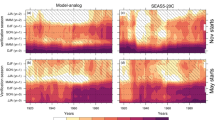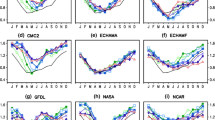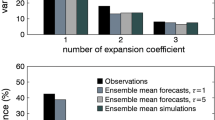Abstract
Forecast skill as a function of the ensemble size is examined in a 24-member ensemble of northern winter (DJF) hindcasts produced with the second generation general circulation model of the Canadian Centre for Climate Modelling and Analysis. These integrations are initialized from the NCEP reanalyses at 6 h intervals prior to the forecast season. The sea surface temperatures that are applied as lower boundary conditions are predicted by persisting the monthly mean anomaly observed prior to the forecast period. The potential predictability that is attributed to lower boundary forced variability is estimated. In lagged-average forecasting, the forecast skill in the first two weeks, which originates predominately from the initial conditions, is greatest for relatively small ensemble sizes. The forecast skill increases monotonically with the ensemble size in the rest of the season. The skill of DJF 500 hPa geopotential height hindcasts in the Northern Hemisphere and in the Pacific/North America sector improves substantially when the ensemble size increases from 6 to 24. A statistical skill improvement technique based on the singular value decomposition method is also more successful for larger ensembles.
Similar content being viewed by others
Author information
Authors and Affiliations
Additional information
Received: 22 February 2000 / Accepted: 6 December 2000
Rights and permissions
About this article
Cite this article
Kharin, V., Zwiers, F. & Gagnon, N. Skill of seasonal hindcasts as a function of the ensemble size. Climate Dynamics 17, 835–843 (2001). https://doi.org/10.1007/s003820100149
Issue Date:
DOI: https://doi.org/10.1007/s003820100149




